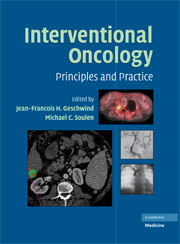Book contents
- Frontmatter
- Contents
- FOREWORD
- ACKNOWLEDGMENTS
- CONTRIBUTORS
- PART I PRINCIPLES OF ONCOLOGY
- PART II PRINCIPLES OF IMAGE-GUIDED THERAPIES
- 5 Image-guided Interventions: Fundamentals of Radiofrequency Tumor Ablation
- 6 Principles of Embolization
- 7 Imaging in Interventional Oncology: Role of Image Guidance
- 8 Assessment of Tumor Response on Magnetic Resonance Imaging after Locoregional Therapy
- PART III ORGAN-SPECIFIC CANCERS
- PART IV SPECIALIZED INTERVENTIONAL TECHNIQUES IN CANCER CARE
- INDEX
- Plate section
- References
6 - Principles of Embolization
from PART II - PRINCIPLES OF IMAGE-GUIDED THERAPIES
Published online by Cambridge University Press: 18 May 2010
- Frontmatter
- Contents
- FOREWORD
- ACKNOWLEDGMENTS
- CONTRIBUTORS
- PART I PRINCIPLES OF ONCOLOGY
- PART II PRINCIPLES OF IMAGE-GUIDED THERAPIES
- 5 Image-guided Interventions: Fundamentals of Radiofrequency Tumor Ablation
- 6 Principles of Embolization
- 7 Imaging in Interventional Oncology: Role of Image Guidance
- 8 Assessment of Tumor Response on Magnetic Resonance Imaging after Locoregional Therapy
- PART III ORGAN-SPECIFIC CANCERS
- PART IV SPECIALIZED INTERVENTIONAL TECHNIQUES IN CANCER CARE
- INDEX
- Plate section
- References
Summary
EMBOLOTHERAPY
General Indications
The percutaneous angiographic technique was first introduced by Seldinger (1), and modern embolotherapy was first attempted by Rösch (2) in 1972 to control duodenal bleeding. The term embolization refers to the induction of vascular occlusion by introducing an embolic agent into a vessel through a selectively placed catheter for therapeutic purposes.
The indications of embolotherapy are various, and include bleeding control, tumor devascularization, arteriovenous fistula and malformations, aneurysms, organ or tissue ablation, varicocele, blood flow redistribution and perigraft leakage. Tumors indicated for devascularization by embolotherapy are renal cell carcinoma (3, 4), angiomyolipoma (5), hepatic tumors (6, 7), bone and soft tissue tumors (8) and uterine fibroids (9). Liver tumor transcatheter arterial embolization (TAE) was first reported by Doyon et al. (10) and chemoembolization using Gelfoam and anti-cancer drugs was reported by Yamada et al. (7).
Recently, catheters with hydrophilic coatings and microcatheter systems have been developed, and currently, the precise and safe delivery of embolic materials is possible to any body location using blood vessels. The embolization process involves the precise localization of a target lesion, the selection of ideal embolic materials, complete embolization of the target lesion and preservation of non-targeted regions. For effective embolization, the selective and superselective techniques are important in terms of inducing complete embolization, and for preserving normal parenchyma and target organ function.
- Type
- Chapter
- Information
- Interventional OncologyPrinciples and Practice, pp. 67 - 77Publisher: Cambridge University PressPrint publication year: 2008
References
- 1
- Cited by

